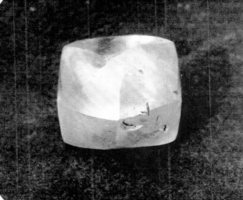 | Back to e-WV
| Back to e-WV
 The West Virginia Encyclopedia
The West Virginia Encyclopedia
 | Back to e-WV
| Back to e-WV
 The West Virginia Encyclopedia
The West Virginia Encyclopedia

Happenstance and a game of horseshoes led to the finding of the Jones Diamond. The diamond, also called the Horseshoe Diamond, was found on Rich Creek, near Peterstown, on Annie and Grover Jones’s property. The Jones family had 17 children, the first 16 of whom were boys, a record for consecutive male births that landed the Joneses in Ripley’s Believe It or Not.
In 1928, while pitching horseshoes, Grover and his oldest son, William ‘‘Punch’’ Jones, found a shiny stone. Punch carried it home, placed it in a box in the tool shed, and forgot about it. During World War II, Punch worked at an ammunition plant, using carbons to make gunpowder. Knowing that diamonds are a crystalline form of carbon, he wondered about the shiny stone he had picked up years earlier. His hunch was confirmed when a geologist at Virginia Polytechnic Institute pronounced the stone an alluvial diamond.
The blue-white gem weighed 34.46 carats and measured 5/8 inch in diameter. One of a few diamonds found in America, it is uncertain how the stone came to Rich Creek. From 1944 to 1968, the Jones Diamond was on display at the Smithsonian Institution. Upon return to West Virginia, it was exhibited at the State Fair. The Joneses owned the diamond until the early 1980s, when it was sold by Sotheby’s for an undisclosed amount.
Hyde, Arnout Jr. New River: A Photographic Essay. Charleston: Cannon Graphics, 1991.
Motley, Charles B. Gleanings of Monroe County. Radford, VA: Commonwealth Press, 1973.
Clark, Nancy. Horseshoe Pitchers Discover Huge Diamond in the Rough. Wonderful West Virginia, (Dec. 1981).